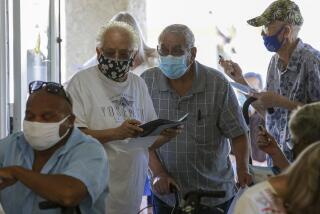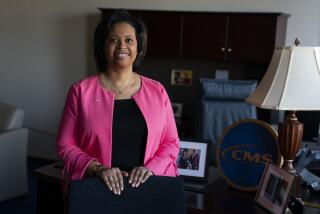21 Million Enrolled in Medicare Drug Plan
- Share via
WASHINGTON — Seniors are signing up for the new Medicare prescription benefit at a strong pace, the government said Thursday, but some independent experts said a closer look at the data reveals that many potential beneficiaries remain on the sidelines.
About 21 million seniors and disabled people are enrolled in one of the private plans that will help with prescription coverage starting Jan. 1, Health and Human Services Secretary Mike Leavitt said, adding: “This is a very strong start.”
But at least 90% of those who have enrolled already had drug coverage -- either through former employers, the Medicaid program or military and federal retirement systems -- federal officials acknowledged. Most did not have to take any steps to change their drug coverage, and may not even realize that Medicare will soon be subsidizing part of it.
Beyond those who already had some form of drug coverage, about 1 million people have signed up for one of several hundred private drug plans that offer the Medicare drug coverage.
“It is difficult to claim success based on these numbers,” said health economist Jack Rodgers of PricewaterhouseCoopers LLP. “What the numbers show is that people who have to do something to enroll in the benefit are not enrolling. The jury is still out.”
Some activists called the government’s interpretation of the figures misleading.
“Nearly 20 million of the 21 million people already had drug coverage,” Robert M. Hayes, president of the Medicare Rights Center in New York, said in a statement. “The voluntary enrollment rate compares miserably with the rate achieved in the 11-month period when Medicare was originally launched in 1966. Nearly all eligible Americans signed up for the program back then.”
The original Medicare program was simpler than the drug benefit, which has been called one of the most complex social benefits ever devised by the federal government. The drug program has also been a subject of controversy, with critics attacking its complicated provisions and some charging that it will unduly benefit drug companies.
Hayes’ group is suing the government over protections for low-income people in the new program.
That 1 million people signed up on their own represents a clear success, said Leavitt’s spokeswoman, Christina Pearson.
“We always said this was going to be a marathon, not a sprint,” she said. “One million people shows momentum.”
Out of the 43 million total Medicare beneficiaries, the government hopes that 28 million to 30 million will enroll by the end of 2006. The administration has spent about $250 million this year to inform and educate seniors about the benefit. The figures released by Leavitt covered the first 28 days of a sign-up period that began Nov. 15 and lasts through May 15.
Enrollment is critical to the success of the program, which uses private insurance plans to deliver a benefit subsidized by the government at an expected cost of $700 billion over 10 years. The more seniors who take the coverage, the higher the likelihood that insurers will stay in the program. And a large risk pool helps to keep costs down.
“They have gotten the easy half,” said James P. Firman, president of the National Council on the Aging, whose group is helping to sign up seniors. “This is the half that we could kind of count on.”
But the government is going to have to keep signing up an average of about 1 million people a month to meet its enrollment goal, Firman estimated. “That’s the number we should be watching in the next couple of months,” he said. “The question is, can they keep that pace?”
Federal officials said they expected 500,000 to sign up in January, but they were anticipating a spike as the May 15 deadline approached. Seniors who sign up after the deadline will have to pay higher premiums permanently.
The 21 million who are now enrolled includes 5.9 million retirees who are receiving drug coverage through their former employers. They will stay in their current plans, but they were counted because the government will now help employers pay the costs, officials said.
It also includes 3.1 million retired federal employees and military veterans who get drug coverage through government retiree benefit programs.
Officials also added in 4.4 million Medicare beneficiaries in managed-care plans who were automatically enrolled in the drug benefit unless they declined.
And they counted 6.2 million seniors and disabled people with very low incomes who are now covered by state-federal Medicaid programs. These beneficiaries are being automatically signed up in drug plans.
Counting these groups is not misleading because Medicare subsidies are helping to maintain or improve their coverage, officials said.
“The drug coverage was set up to do two things: Provide coverage to people who don’t have it, and also preserve coverage for people who do,” Medicare spokesman Gary Karr said.
More to Read
Sign up for Essential California
The most important California stories and recommendations in your inbox every morning.
You may occasionally receive promotional content from the Los Angeles Times.










